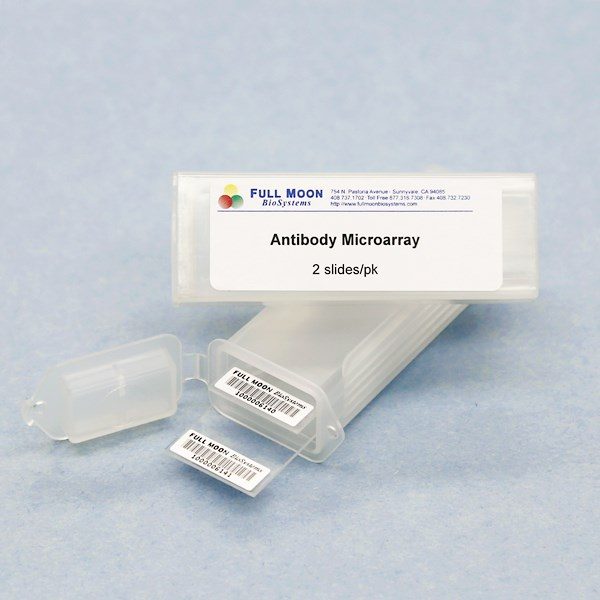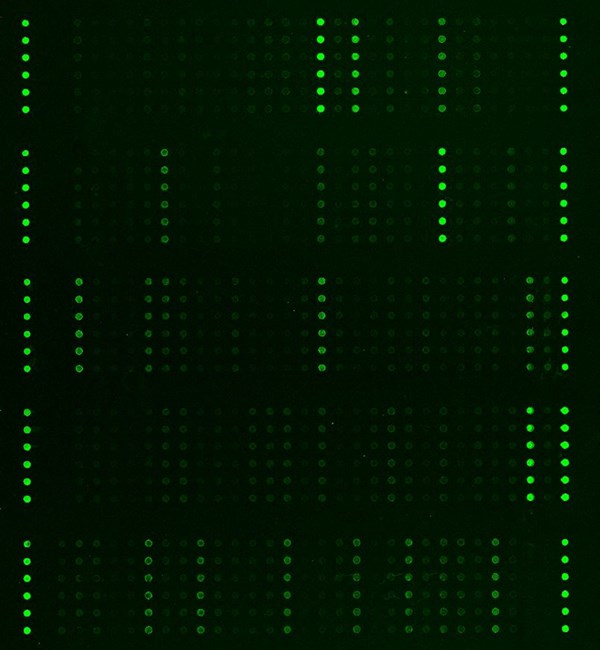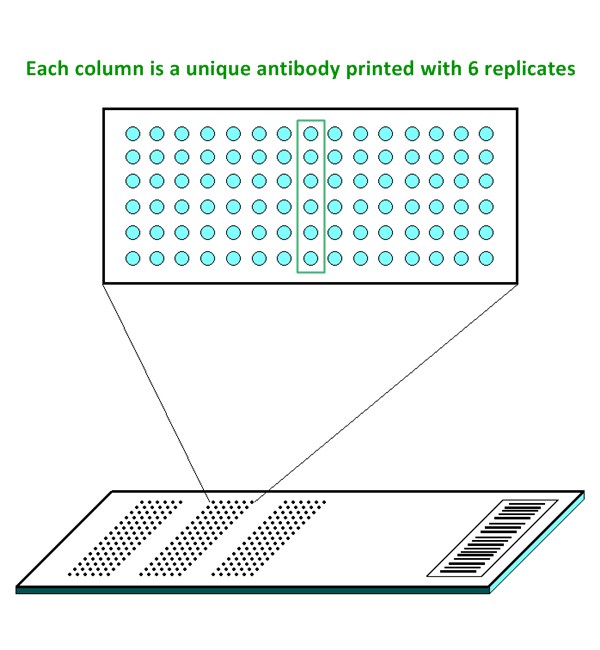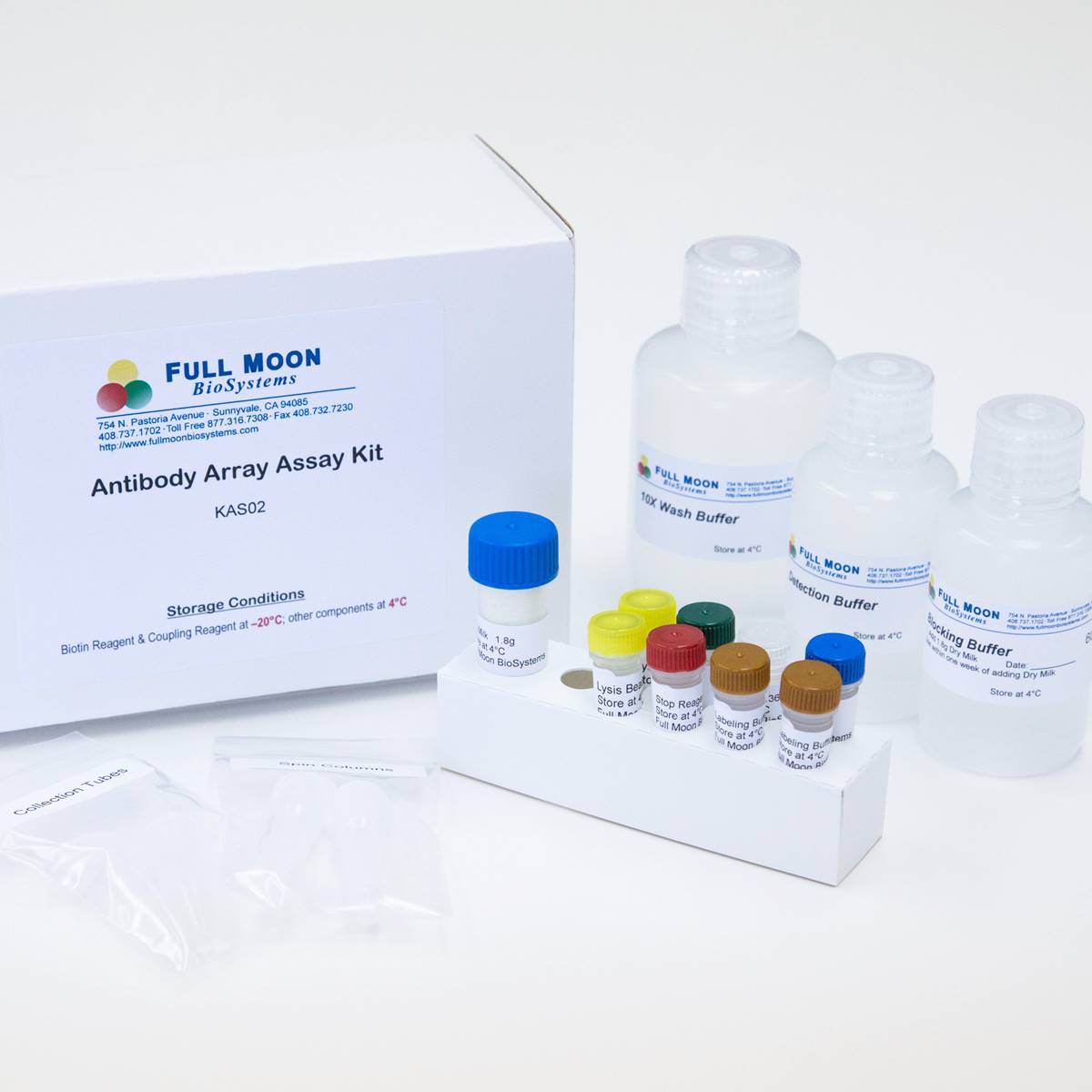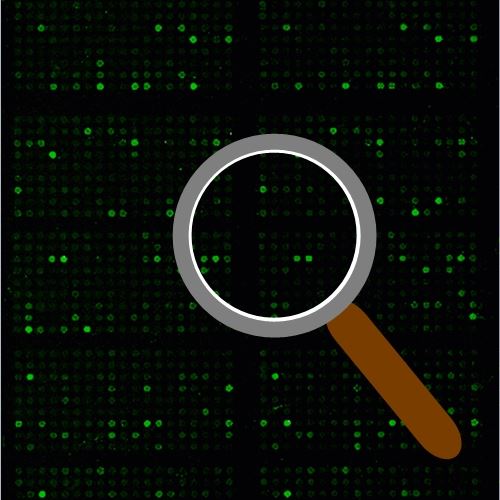GPCR Signaling to MAPK/ERK Phospho Antibody Array
GPCR Signaling to MAPK/ERK Phospho Antibody Array is a high-throughput ELISA based antibody array for qualitative protein phosphorylation profiling. It is suitable for comparing normal samples to treated or diseased samples, and identifying candidate biomarkers. This array features site-specific and phospho-specific antibodies, allowing researchers to study tyrosine phosphorylation and serine/threonine phosphorylation at specific sites.
Key Features
- Site-specific phosphorylation profiling and screening with 193 antibodies
- Antibodies covalently immobilized on 3D polymer coated glass slide
- Fluorescent detection
Specifications
| Product Size: | 2 array slides per package for analyzing two samples (untreated vs. treated) |
| Featured Antibodies: | 193 site-specific and phospho-specific antibodies; 6 replicates per antibody |
| Reactivity: | Human: 100% | Mouse: 95% | Rat: 81% |
| Suitable Sample Type: | Cell lysate | Tissue lysate |
| Detection Method: | Fluorescence | Compatible Scanners |
| Internal Controls: | Positive controls: beta-actin | GAPDH | Negative controls |
| Slide dimensions: | 76 x 25 x 1 mm |
| Storage Condition: | 4°C for 6 months |
PRODUCT DETAILS
Arrestin-1 (Ser412), B-Raf (Ser446), B-Raf (Ser601), B-Raf (Thr598), CaMK2 (Thr286), CaMK2-b/g/d (Thr287), CaMK4 (Thr196/200), CaMK5, CDC25A (Ser124), CDC25A (Ser75), CDC25B (Ser323), CDC25B (Ser353), CDC25C (Ser216), CDC25C (Thr48), c-PLA2 (Ser505), c-Raf (Ser296), c-Raf (Ser43), DYN1 (Ser774), ERK1/2, ERK3 (Ser189), ERK8 (Thr175/Tyr177), FAK (Ser910), FAK (Tyr397), FAK (Tyr407), FAK (Tyr576), FAK (Tyr861), FAK (Tyr925), FOXO1/3/4-PAN (Thr24/32), FOXO1A/3A (Ser322/325), FOXO3A (Ser253), GRB2 (Ser159), GRK2 (Ser29), GRK2 (Ser685), GTPase activating protein (Ser387), Integrin b1 (Thr788), Integrin b3 (Tyr773), Integrin b3 (Tyr785), Integrin b5, JNK1/2/3 (Thr183/Tyr185), KSR (Ser392), KSR2, MAPKAPK2 (Ser272), MAPKAPK2 (Thr222), MAPKAPK2 (Thr334), MEK1 (Ser217), MEK1 (Ser221), MEK1 (Ser298), MEK1 (Thr286), MEK1 (Thr291), MEK2 (Thr394), MKP-1 (Ser359), MKP-1/2 (Ser296), MSK1 (Ser212), MSK1 (Ser360), MSK1 (Ser376), MSK1 (Thr581), MSK2 (Thr568), p44/42MAPK (Thr202), p44/42MAPK (Tyr204), P90RSK (Ser380), P90RSK (Thr359/Ser363), P90RSK (Thr573), PEA-15 (Ser104), PEA-15 (Ser116), PI3K-p85-a/g (Tyr467/Tyr199), PKA CAT (Thr197), PKC alpha (Tyr657), PKC alpha/beta II (Thr638), PKC beta (Ser661), PKC delta (Tyr52), PKC delta (Ser645), PKC delta (Thr505), PKC delta (Tyr313), PKC delta (Tyr64), PKC epsilon (Ser729), PKC pan activation site, PKC theta (Ser676), PKC theta (Thr538), PKC zeta (Thr410), PKC zeta (Thr560), PKD1/PKC mu (Ser205), PKD1/PKC mu (Ser910), PKD1/PKC mu (Tyr463), PLC beta (Ser1105), PLC beta3 (Ser537), Pyk2 (Tyr402), Pyk2 (Tyr579), Pyk2 (Tyr580), Pyk2 (Tyr881), RASE, RASF4, Ras-GRF1 (Ser916), RGS16 (Tyr168), Src (Ser75), Src (Tyr216), Src (Tyr418), Src (Tyr529), SYN1 (Ser62), SYN1 (Ser9), TAK1 (Thr184), Tyrosine Hydroxylase (Ser19), Tyrosine Hydroxylase (Ser31), Tyrosine Hydroxylase (Ser40), Tyrosine Hydroxylase (Ser8)
The ELISA based GPCR Signaling To MAPK/ERK Phospho Antibody Array platform involves four major steps:
- Protein extraction with non-denaturing lysis buffer
- Biotinylation of protein samples
- Incubation of labeled samples with antibody array
- Detection by dye conjugated streptavidin
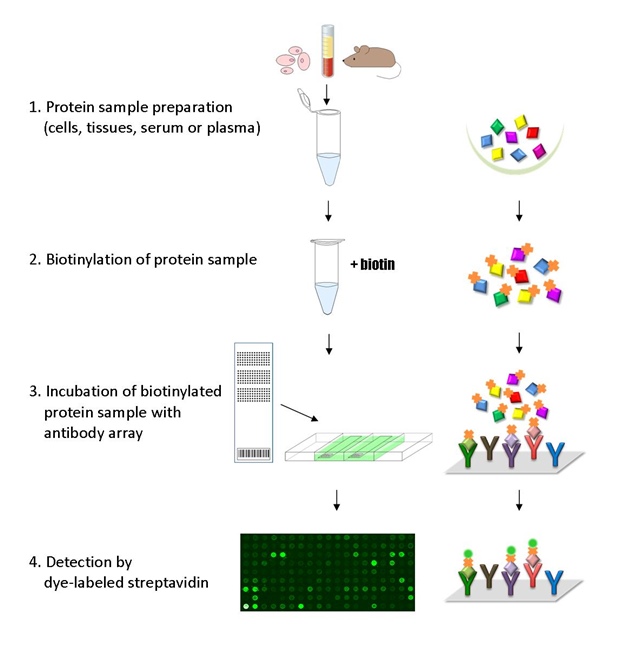
![]() GAL File (To download, right click on the file name, then choose “Save target as”)
GAL File (To download, right click on the file name, then choose “Save target as”)
Huang G, Tao L, Hypoxia induced CCL28 promotes angiogenesis in lung adenocarcinoma by targeting CCR3 on endothelial cells. Scientific Reports 6, 27152; doi:10.1038/srep27152
Lee M, PSAT157 Efficacy of Bisphosphanate Treatment in Pediatric Patients with Osteoporosis Due to Immobilization, Journal of the Endocrine Society Volume 6; Issue Supplement_1. November-December 2022. Page A197. https://doi.org/10.1210/jendso/bvac150.405
Song H, Yang Y, Tripeptide Hyp-Asp-Gly from collagen peptides inhibited platelet activation via regulation of PI3K/Akt-MAPK/ERK1/2 signaling pathway, J Food Sci. 2022 Jun 15. doi: 10.1111/1750-3841.16215
ADDITIONAL SERVICES
If you don’t have access to a microarray, send the finished arrays to our lab for scanning. Raw scan images are delivered in tiff format.
Cost: Free
Array Image Quantification and Analysis Service includes data extraction, data organization and analysis of the array images obtained through our array scanning service.
Cost: $200 per slide
Complete Antibody Array Assay Service allows investigators to send research samples to our laboratory for analysis. There is no need to purchase the arrays and reagents and running the assays yourself. Simply select the array of your choice, and then send off the samples to our lab. This convenient hands-off approach offers quick turnaround and reliable results, saving you valuable time and resources. All assays will be performed by our highly trained scientists at our headquarter in Sunnyvale, California. Results are delivered by email in 1-3 weeks.
Cost: $1,470 per sample

